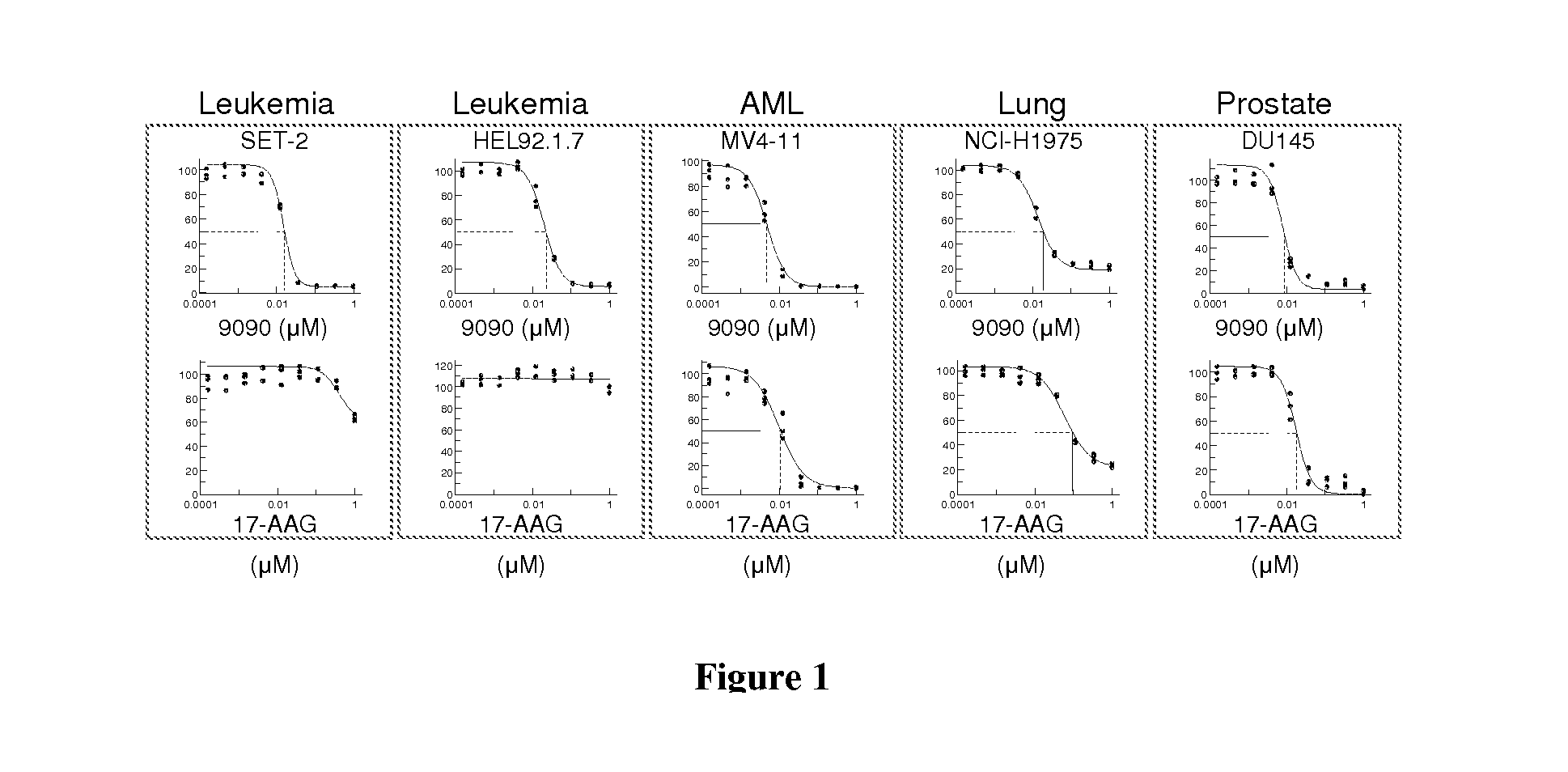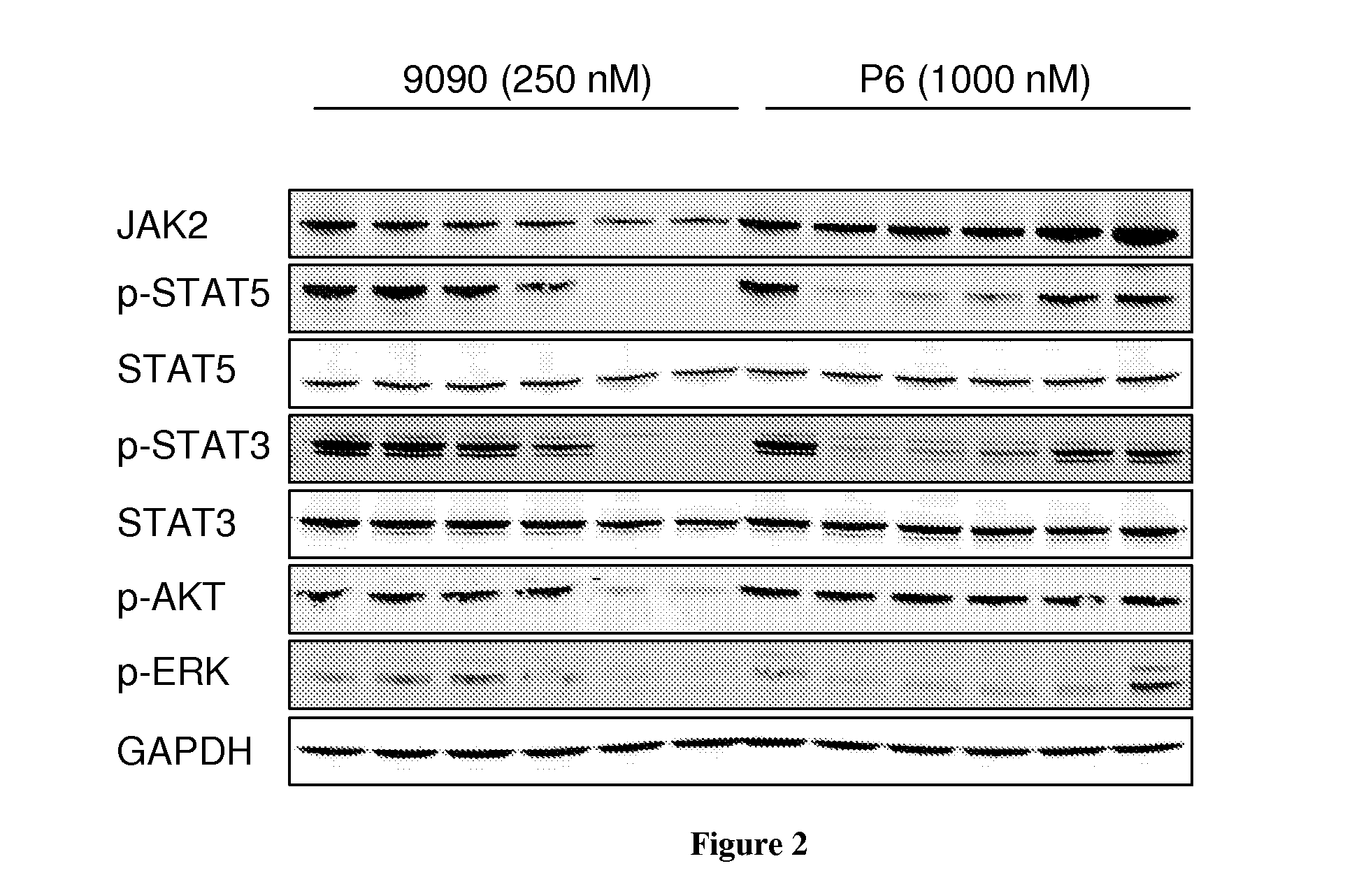Hsp90 inhibitory compounds in treating jak/stat signaling-mediated cancers
a technology of inhibitory compounds and cancers, applied in the direction of heterocyclic compound active ingredients, biocide, drug compositions, etc., can solve the problems of unsatisfactory current chemotherapy, less likely that a therapeutic agent that acts on one molecular target will be fully effective, and the prognosis of the majority of patients diagnosed with cancer remains poor. , to achieve the effect of surprising effectiveness in treating a subj
- Summary
- Abstract
- Description
- Claims
- Application Information
AI Technical Summary
Benefits of technology
Problems solved by technology
Method used
Image
Examples
example 1
Ganetespib Inhibition of JAK2-Mediated Signal Transduction and Proliferation in Hematological Cancers
[0171]Ganetespib has low nanomolar potency and reduced cellular viability in a group of human hematological and solid tumor cell lines selected for their dependence on JAK / STAT signaling and varying cancer type (FIG. 1). In each of the lines tested, ganetespib was more potent than the ansamycin Hsp90 inhibitor 17-AAG. Ganetespib was greater than 100 fold more potent than 17-AAG in the SET-2 and HEL92.1.7 leukemia cells, cell lines harboring constitutively active JAK2V617F mutations that act as their oncogenic drivers. Using the HEL92.1.7 cells, the comparison was made of the JAK / STAT inhibitory activity of ganetespib with the compound Pyridone-6 (P6), a reversible, ATP-competitive pan inhibitor of the JAKs (FIG. 2). It can be seen that ganetespib and P6 each blocked JAK2 dependent signaling, as evidenced by the loss of phospho-STAT3 and phospho-STAT5, and ERK signaling. However, gane...
example 2
Ganetespib Abrogates JAK / STAT Signaling in Solid Tumors
[0172]In addition to its incidence in hematologic malignancies, oncogenic STAT activation is also prevalent in a range of solid tumors. For example, persistently activated STAT3 is found in 50% of lung adenocarcinomas and is primarily observed in tumors harboring somatic-activating mutations in the epidermal growth factor receptor (EGFR). The NCI-H1975 non-small cell lung cancer (NSCLC) cell line expresses the Hsp90 client EGFRL858R / T790M, a constitutively activated and erlotinib-resistant form of EGFR, and ganetespib treatment resulted in a dose dependent decrease in EGFR expression in these cells (FIG. 4). Moreover, ganetespib also induced potent degradation of JAK2 and loss of phosphorylated STAT3 in a dose-dependent manner. Inactivation of AKT and GSK3β, proteins important in regulating apoptosis, was observed with a similar dose response to that of JAK2 / STAT3 signaling. It has been shown that JAK2 can modulate the activity ...
example 3
Hsp90 Inhibition Downregulated Transcription of JAK / STAT Signaling Targets and Cell Cycle Genes
[0175]In HEL92.1.7 erythroleukemia cells, biochemical inhibition of JAK2 by P6 treatment resulted in a loss of cellular viability, but with 30 fold less potency than ganetespib (IC50 values 614 vs. 20 nM) (FIG. 8). To compare the cellular impact of each inhibitor, conditions were identified under which JAK2 activity was reduced to equivalent levels by each drug based on their kinetic and potency differences. As illustrated in FIG. 9, the 4 hour P6 (1000 nM) and 24 hour ganetespib (250 nM) treatments were selected because of comparable effects on STAT3 / 5 signaling. RNA expression profiling at these time points revealed that many JAK / STAT target genes, such as SOCS and PIM family members, were downregulated by both drugs. However, additional genes were altered by ganetespib treatment that was unaffected in the P6-treated cells. Besides leading to the up-regulation of numerous heat shock prot...
PUM
| Property | Measurement | Unit |
|---|---|---|
| concentrations | aaaaa | aaaaa |
| time | aaaaa | aaaaa |
| time | aaaaa | aaaaa |
Abstract
Description
Claims
Application Information
 Login to View More
Login to View More - R&D
- Intellectual Property
- Life Sciences
- Materials
- Tech Scout
- Unparalleled Data Quality
- Higher Quality Content
- 60% Fewer Hallucinations
Browse by: Latest US Patents, China's latest patents, Technical Efficacy Thesaurus, Application Domain, Technology Topic, Popular Technical Reports.
© 2025 PatSnap. All rights reserved.Legal|Privacy policy|Modern Slavery Act Transparency Statement|Sitemap|About US| Contact US: help@patsnap.com



